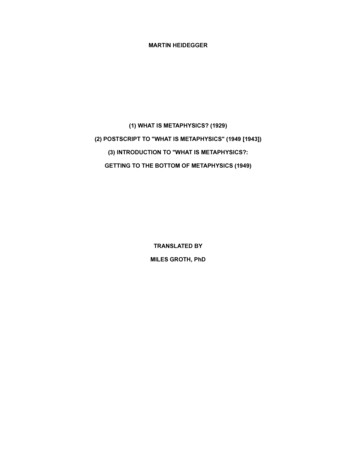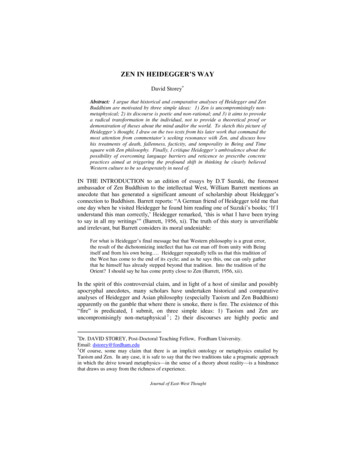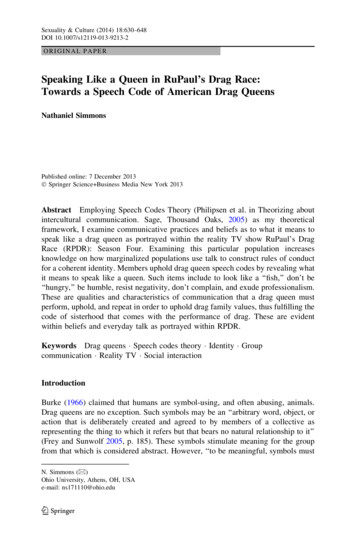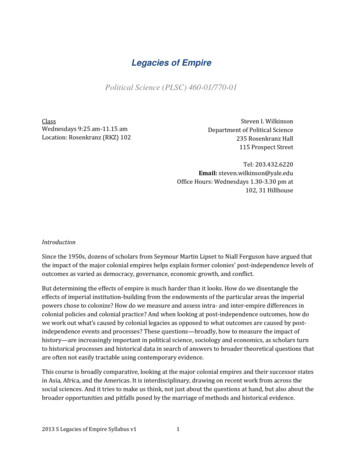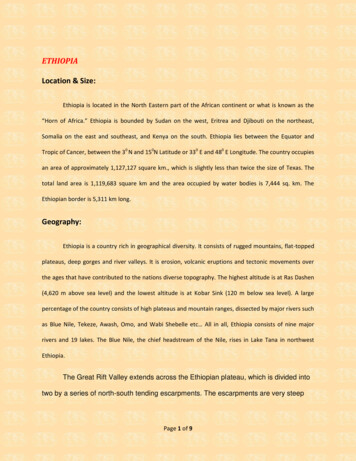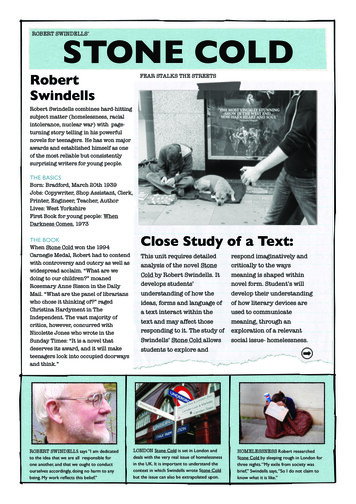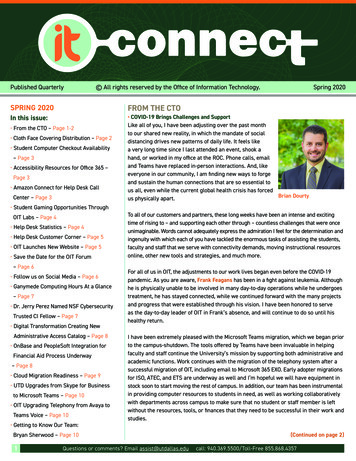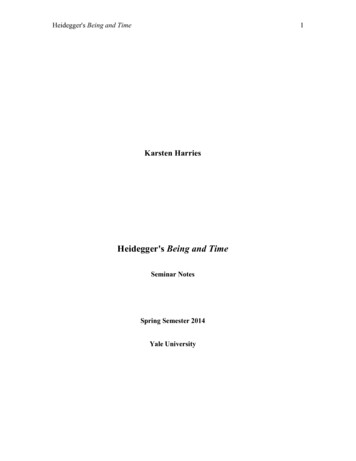
Transcription
Heidegger's Being and Time1Karsten HarriesHeidegger's Being and TimeSeminar NotesSpring Semester 2014Yale University
Heidegger's Being and Time2Copyright Karsten Harrieskarsten.harries@yale.edu
Heidegger's Being and Time3Contents1. Introduction42. Ontology and Fundamental Ontology163. Methodological Considerations304. Being-in-the-World435. The World556. Who am I?697. Understanding, Interpretation, Language828. Care and Truth969. The Entirety of Dasein11310. Conscience, Guilt, Resolve12811. Time and Subjectivity14512. History and the Hero15813. Conclusion169
Heidegger's Being and Time41. Introduction1In this seminar I shall be concerned with Heidegger's Being and Time. I shallrefer to other works by Heidegger, but the discussion will center on Being and Time. Inreading the book, some of you, especially those with a reading knowledge of German,may find the lectures of the twenties helpful, which have appeared now as volumes of theGesamtausgabe. Many of these have by now been translated. I am thinking especially ofGA 17 Einführung in die phänomenologische Forschung (1923/24); Introductionto Phenomenological Research, trans. Daniel O. Dahlstrom (Bloomington, IndianaUniversity Press, 2005)GA 20 Prolegomena zur Geschichte des Zeitbegriffs (1925); History of theConcept of Time, trans. Theodore Kisiel (Bloomington, Indiana University Press, 1985)GA 21 Logik. Die Frage nach der Wahrheit (1925/26). Logic: The Question ofTruth, trans. Thomas SheehanGA 24 Die Grundprobleme der Phänomenologie (1927); The Basic Problems ofPhenomenology, trans. Albert Hofstadter (Bloomington, Indiana University Press, 1982)GA 26 Metaphysische Anfangsgründe der Logik im Ausgang von Leibniz (1928);The Metaphysical Foundations of Logic, trans. Michael Heim (Bloomington, IndianaUniversity Press, 1984)GA 29/30 Die Grundbegriffe der Metaphysik (1929/30); The FundamentalConcepts of Metaphysics World, Finitude, Solitude, trans. William McNeill and NicholasWalker (Bloomington, Indiana University Press, 1995.GA 60 Phänomenologie des religiösen Lebens (1920/21); The Phenomenology ofReligious Life, trans. Matthias Fritsch and Jennifer Anna Gosetti-Ferencei (Bloomington,Indiana University Press, 2004)But I do not expect most of you to read any of these. Being and Time is quite enough. Iam not recommending any secondary literature, at least not initially. If you want anoverview of Heidegger's development, I recommend Rüdiger Safranski’s Ein Meister ausDeutschland, translated as Martin Heidegger: Between Good and Evil. Walter Biemel's
Heidegger's Being and Time5Martin Heidegger, translated into English as Martin Heidegger: An Illustrated Study ishelpful. I prefer Otto Pöggeler's Martin Heidegger's Path of Thinking. I cannot reallyrecommend any of the commentaries on Being and Time. I considered ordering StephenMunhall’s recently revised commentary1 and making you write a review. It is clear andresponsible, but it does not dig very deeply. So I gave up on that idea. You do better toconcentrate on the text. Genuinely helpful is Theodore Kisiel’s Genesis of Being andTime. But more important than consulting the secondary literature would be turning tothe sources of Heidegger's thinking, above all to Aristotle, but also to Plato, Augustine,Descartes, Leibniz, Kant, Hegel, and, of course, Husserl.2In approaching Being and Time it is helpful to keep in mind that the book, as wehave it, contains only the first two sections of part one, that is to say roughly one third ofthe envisioned work.That the book we have is only a fragment of the work envisioned at the time ismade clear in paragraph 8, which presents us with a sketch of the “Design of theTreatise” (SZ 39-40)2 — with its rushed publication Heidegger responded to pressure bythe dean of the philosophical faculty at Marburg, which had chosen him to succeedNicolai Hartmann, but was informed by the ministry in Berlin that a major publicationwas needed (GA14, 99)3. That “Design” tells us that the book we now have containsonly the first two sections of Part One, that is to say roughly one third of the envisionedtwo part work. As Heidegger explains the overall design:If we are to arrive at the basic concept of ‘Being’ and to outline theontological conceptions which it requires and the variations which itnecessarily undergoes, we need a clue which is concrete. We shallproceed towards the concept of Being by way of an Interpretation of a1Stephen Munhall, Heidegger;’s Being and Time, 2nd. ed. (London and New York:Routledge, 2013) .2GA2 Sein und Zeit (1927); Being and Time, trans. John Macquarrie and EdwardRobinson (New York: Harper and Row, 1962). Page references are to the 7th edition ofSZ, 1953.3GA14 Zur Saches des Denkens (1969); Tr. On Time and Being, trans. Joan Stambaugh(New York: Harper and Row, 1972)
Heidegger's Being and Time6certain special entity, Dasein, in which we shall arrive at the horizon forthe understanding of Being and for the possibility of interpreting it; theuniversality of the concept of Being is not belied by the relatively ‘special’characteristic of our investigation. But this very entity, Dasein, is in itself‘historical’, so its ownmost ontological elucidation necessarily becomes an‘historiological’ (‘historischen’) Interpretation.” (SZ 39)This tells us that the projected third section of Part One would have returned to the taskof determining the concept of Being, after an analysis of the temporality of Dasein hadprovided the necessary horizon. Heidegger’s “design” also suggests that such adetermination could still only have been provisional in that an adequate determination ofthe concept of Being is said to call for the three step destruction of the history ofphilosophy that Part Two of Being and Time was supposed to accomplish, a destructionthat would have led the reader back to the origin of Greek ontology and thus to the limitof philosophy as we know it, and with it to a more original understanding of both timeand Being than allowed for by the phenomenological-transcendental approach adopted inBeing and Time. Such a “destruction” has to call into question the phenomenologicalmethod for which Heidegger thanks his mentor Edmund Husserl in a footnote (SZ 39), amethod that remains rooted in the tradition to be “destroyed.”Already here then we get a premonition of the collision between the claim ofphenomenology to lay firm foundations and an ever growing awareness of the historicalembeddedness of thought, a collision that, as we shall see, dooms any attempt to arrive atan adequate determination of the concept of Being. That impossibility becomes explicitin subsequent works: there is indeed tension already in the very expression “concept ofBeing” in that Being resists being assigned its place in logical or linguistic space.Much of the destruction of the history of philosophy promised for the projectedPart Two is now available in one form or another, both in Heidegger’s lectures and in hispublished essays. But what about the third section of Part One of Being and Time?Paragraph 8 gives only its title, “Time and Being.” What strikes the reader immediately isthe reversal that has taken place: instead of journeying from Being to time we now are toreturn from time to Being, raising the question of whether the much discussed Kehre inHeidegger’s path of thinking, supposed to have taken place several years after the
Heidegger's Being and Time7publication of Being and Time, had in fact already been anticipated in the originalprojection of the work.3It has become customary to contrast Being and Time and the immediatelyfollowing published works, The Essence of Reasons, Kant and the Problem ofMetaphysics and What is Metaphysics? — and we can now add to these The BasicProblems of Phenomenology and other lectures — with the later works, beginning withthe Introduction to Metaphysics and The Origin of the Work of Art (1935). Pöggeler andvon Herrmann have celebrated the Beiträge zur Philosophie (Vom Ereignis) (1936 - 38),Contributions to Philosophy, published posthumously some years ago as GA 65, asHeidegger's second main work, which makes the turn from a Dasein-centered explicationof the problem of time as horizon of the question of Being to a restatement of thisquestion in terms of the history of Being (Cf. von Herrmann's essay in Martin Heidegger,Politics, Art, and Technology.4 But such talk of the famous Kehre or turning ismisleading in at least two ways:1. The later works should not be lumped together. As Pöggeler points out in theConcluding Discussion in Politics, Art, and Technology,5 there are at least two importantbreaks in Heidegger's development, one comes in 1929/30, the second in 1938. Pöggeleris right to point out that 1933 does not represent an important turn in Heidegger'sphilosophical development, although I would question his claim that therefore there is nodeep connection between Heidegger's political engagement and his philosophicaldevelopment. It is possible to argue that it was precisely Heidegger's need to confront,not just National Socialism, but also his own involvement with it, that called for the moveto the third stage. In this sense the Rekotoratsrede does hold a central place in that stagewhich lasts from 1929/30 to 1938. I treated this in some detail in my seminar onHeidegger’s “The Origin of the Work of Art,” which now has appeared as a book with4Friedrich-Wilhelm von Herrmann, "Technology, Politics, and Art in Heidegger'sBeiträge zur Philosophie, trans. Karsten Harries and Parvis Emad, Martin Heidegger:Politics, Art, and Technology, ed. Karsten Harries an d Christoph Jamme (New York:Holmes and Meier, 1994), p. 55-705Politics, Art, and Technology, p. 247.
Heidegger's Being and Time8Springer.6 The chapter dealing with the Rectorial Address has also appeared in a Frenchtranslation by Christian Sommer.72. More importantly, Being and Time is not Heidegger's first work. Anyone whowants to have an adequate understanding of Heidegger's development should be familiarwith his dissertation of 1914, Die Lehre vom Urteil im Psychologismus and theHabilitationsschrift of 1916, Die Kategorien- und Bedeutungslehre des Duns Scotus (GA1), should also be aware of his difficult movement away from Catholicism, first to a freeProtestantism and finally beyond Christianity altogether. I recommend Hugo Ott's"Heidegger's Catholic Origins" in Politics, Art, and Technology8 and especially hisMartin Heidegger.9 And, as more and more volumes of the GA have appeared and stillcontinue to appear, the importance of Aristotle for Heidegger's appropriation of Husserl'sphenomenological project has become ever more apparent. But here I shall focus onBeing and Time.4Still, by way of an introduction let me briefly and very roughly and thereforemisleadingly sketch Heidegger’s development and the place of Being and Time in thatdevelopment. I want to do so by drawing a parallel between Heidegger’s developmentand that of Wittgenstein. I would like to mark the latter with some quotations:Tractatus 4.003. Language disguises the thought: so that from theexternal forms of the clothes one cannot infer the form of the thought theyclothe, because the external form of the clothes is constructed with quiteanother object than to let the form of the body be recognized.10On this view language hides its essential structure, just as the body hides the spirit.6Karsten Harries, Art Matters: A Critical Commentary on Heidegger’s The Origin of theWork of Art (New York: Springer, 2009).7“Le Discours de rectorat et le ‘national-socialisme privé’ de Heidegger,” ÉtudesPhilosophiques, 2010 - N 2 Presses Universitaires de France - PUF; (26 mai 2010)8Hugo Ott, "Heidegger's Catholic Origins", Politics, Art, and Technology, ed. KarstenHarries and Christoph Jamme (New Yirk: Holmes and Meier, 1994, pp. 18-33.9Hugo Ott, Martin Heidegger: Unterwegs zu seiner Biographie (Frankfurt am Main:Campus, 1988).10Ludwig Wittgenstein, Tractatus Logico-Philosophicus, trans. C. K. Ogden (London:Routledge and Kegan Paul, 1958),.
Heidegger's Being and Time93. 324 Thus there easily arise the most fundamental confusions (of whichthe whole of philosophy is full)To avoid such confusions we have to develop an artificial language that does not obscurethe essence of language. The sign language of the Tractatus answers to this demand.My second quote is from the Philosophische Bemerkungen or PhilosophicalRemarks of 1930:3. How strange if logic were to concern itself with an 'ideal' language andnot with ours. For what should this ideal language express? Presumablywhat we are expressing in our ordinary language; but then logic mustinvestigate it. Or something else: but how then am I to know what that is.The logical analysis is the analysis of something that we have, not ofsomething that we do not have. It is therefore an analysis of propositionsas they are. (It would be strange if human society had spoken until nowwithout succeeding in uttering a single correct proposition.) 11My last quotation is from the Philosophical Investigations.23. It is interesting to compare the multiplicity of the tools in languageand of the ways they are used, the multiplicity of kinds of word andsentence, with what logicians have said about the structure of language(including the author of the Tractatus Logico-Philosophicus.) 12Heidegger's thought underwent a similar development. The early Heideggerdemands that logic be freed from grammar, appealing in this connection to Emil Lask,Die Lehre vom Urteil. (GA 1, 178, especially note) This demand for an emancipation oflogic from grammar is explicitly rejected and indeed reversed in Being and Time:The task of liberating grammar from logic requires beforehand a positiveunderstanding of the basic a priori structure of discourse in general as anexistentiale. It is not a task that can be carried through later on byimproving and rounding out what has been handed down. Bearing this inmind, we must inquire into the basic forms in which it is possible toarticulate anything understandable, and to do so in accordance with11Ludwig Wittgenstein, Philosophische Bemerkungen, ed. Rush Rhees, Schriften. vol. 2(Frankfurt am Main: Surkamp, 1964), p. 52.12Ludwig Wittgenstein, Philosophical Investigations, trans. G. E.M. Anscombe (Oxford:Blackwell, 1958).
Heidegger's Being and Time10significations; and this articulation must not be confined to entities withinthe-world which we cognize by considering them theoretically, and whichwe express in sentences. (SZ 165-166)We shall return to this passage later, in its proper context. But let us ask in a preliminaryfashion: how is the apriorische Grundstruktur von Rede to be understood? Traditionallythe assertion has been understood as paradigmatic speech. In his dissertation, Die Lehrevom Urteil, Heidegger had given the example: "the cover of the book before me isyellow."Why the focus on an assertion? In Being and Time Heidegger will link this focusto an Ontologie des Vorhandenen, to an ontology of the present-at-hand. We shall returnto this later, but we see already how the philosophy of language and ontology intertwine.The question of Being intertwines in turn with the question: what constitutes properaccess to beings? To understand Being as presence-at-hand is to transform theexperiencing human subject into first of all a subject standing before a world of objects.The world is transformed into a picture. It is understood as the totality of what is thecase. But perhaps we should stick to the term "object": that such an understanding restson a reduction of everyday experience is apparent.What is the relationship of language to these facts? Consider Heidegger'sexample: "the cover of the book before me is yellow." The predicate expressessomething that is said to be valid of the subject. The copula "is" claims such validity.The proposition communicates a content that remains what it is regardless of what as amatter of fact is the case.Consider another judgment: the sky is blue" and imagine it made in differentcircumstances, by a gardener perhaps, or by a child, or by a lover. Do we have the samejudgment in each case? In the dissertation Heidegger had argued that despite possibledifferences in connotation the content remains the same. It is this content which he therecalls Sinn (meaning). It is this Sinn, not what happens to be its linguistic expression, thatis said to concern the logician. And it is as a logician that the young Heideggerunderstands himself; it is through logic that he enters philosophy. And, with frequentreferences to both Aristotle and Husserl, the word "logic" was to continue to figureprominently in the lecture courses of the twenties:GA 21: Logik. Die Frage nach der Wahrheit (1925/26)
Heidegger's Being and Time11GA 26: Metaphysische Anfangsgründe der Logik (1928)In his dissertation Heidegger understood logic as the theory of Sinn. He divides thattheory into three parts:1. The doctrine of the elements of meaning— Lehre vom Begriff, the doctrine ofthe concept.2. The doctrine of the structures of meaning— Lehre vom Urteil, the doctrine ofjudgment.3. The doctrine of meaning — Lehre von der Wissenschaft, the doctrine ofscience.Rather like Wittgenstein in the Tractatus Heidegger calls the sphere of Sinn alogischer Bereich, a logical realm. Meanings fall into different groupings. These areprovided by the categories of meaning, the Bedeutungskategorien, the fundamentalprinciples constitutive of classes of meaning. The investigation into these categories ofmeaning was the point of the speculative grammar of Thomas of Erfurt, then stillconfused with Duns Scotus, which Heidegger is discussing in the second part of hisHabilitationsschrift: Nomen, pronomen, verbum, adverbium, participium, conjunctio,praepositio, and interjectio, are such categories of meaning. But our investigations neednot remain that general. We can, for example, investigate the grammar of "red."Heidegger, too, understands the proposition as determining a "logical place." Thesimilarity with the Tractatus is apparent:3.4. The proposition determines a place in logical space. The existence ofthis logical place is assured by the existence of its constituent parts, by theexistence of the meaningful sentence (des sinnvollen Satzes).One might also want to speak, thinking of Husserl, of an eidetic space.All important, given this picture, is the separation of the ontic from the logical,the distinction between the realm of facts and the realm of meanings. The latter offersroom not only to this world, but to all possible worlds. It offers a structure into which allthese worlds must fall. Logic is transcendental.If meaning essentially transcends facts, all attempts to ground meaning in factmust be mistaken, rest on a category mistake. Logic thus cannot be grounded inpsychology. And Heidegger never was to leave this distinction altogether behind. Itreappears, transformed as the ontologische Differnenz, as the distinction between beings
Heidegger's Being and Time12and their Being. In Being and Time he will thus insist that “Being can never be explainedby entities but is already that which is ‘transcendental’ for every entity (SZ 208). Whathe does call into question in Being and Time is the privileging of assertion, just asWittgenstein does in the Philosophical Investigations. In both cases transcendentalphilosophy is brought down to earth. But is this not perhaps a confusion? Was theemphasis on logic as the transcendental presupposition of experience, an emphasis thatdominated philosophy in the time before the First World War, really mistaken? Did thatwar have anything to do with the shift in the philosophical climate?5But let me return to the quote from Being and Time: what does Heidegger meanby an existentiale?Let us get some terms straight: we have already discussed the distinction betweenthe logical or transcendental and the ontic. The distinction between ontological and onticis related: ontology is the inquiry into the structures constitutive of entities. Its object isthe exhibition of categories. Kant is thus an ontologist in Heidegger’s sense when hetries to exhibit the categories. But Kant was not willing to put the presupposedunderstanding of experience into question. And yet, as the other two Critiquesdemonstrate, the presupposed notion of experience rests on a reduction. A morefundamental questioning of experience is therefore needed: what are the structuresconstitutive of human being-in-the-world? The inquiry into these structures Heideggerterms fundamental ontology. The structures are called existentialia. Existential :existentiell ontological : ontic. The paragraph thus makes clear that Heidegger wantsto challenge his earlier effort by showing that it uncritically based itself on a particularinterpretation of experience and, inseparable from it, on a particular uncritically adoptedunderstanding of Being. That understanding has ruled the progress of philosophy. Byraising the question of Being Heidegger calls that progress in its entirety into question.That is why the second part of Being and Time called for a destruction of the history ofontology.Just in passing I would like to mention here a certain parallel between Heideggerand Descartes: Descartes recognized that his metaphysics of nature, his interpretation ofthe being of the objects of science as res extensa, needed for its foundation a metaphysics
Heidegger's Being and Time13of the soul, an analysis of the being of human being as res cogitans. That "fundamentalontology" was to secure that access to beings provided by clear and distinct thinking.That "fundamental ontology" in turn was recognized to be in need of a furtherfoundation. Descartes’ philosophical theology addresses that need. Heidegger of coursewould have us question Descartes’ attempt as insufficiently fundamental. The Being ofentities cannot be grounded in a being, not even in the most perfect being, i.e. God.6I have drawn a parallel between Heidegger and Wittgenstein, but the paragraphthat I quoted also points to a decisive difference. Heidegger seems more traditional inBeing and Time by clinging to the distinction between ontological and ontic, a version ofthe traditional distinction between essence and fact. It is a distinction Wittgensteinsubjects to criticism in the Philosophical Investigations. Do we need a notion ofessence? We shall return to this point.But let me here point to another decisive difference between the two thinkers:Heidegger will insist on distinguishing authenticity from inauthenticity. Everydaylanguage in its entirety he understands as a phenomenon of inauthenticity. Heidegger isthus unwilling to accept ordinary language as something like a Grund, a ground. Thuswhile at first one may be struck by parallels that link Wittgenstein and Heidegger, by thetime we get to Part 2 of Being and Time, there are deep differences that will become evermore important.Like Wittgenstein, Heidegger leads philosophy in Being and Time to a pointwhere the philosophic enterprise in its entirety is called into question. He does so byshowing that philosophy is a discipline without adequate foundation or ground. Thisopposes the Cartesian understanding of philosophy as a kind of conceptual architecturethat first lays and then builds on firm foundations. Heidegger would seem to do just theopposite: today we might say he is in the business of deconstruction rather than in that ofconstruction, that is to say, he forces us to recognize that there is no such ground. In thisrespect Heidegger is more radical than Wittgenstein who only denies that philosophy canestablish such a ground, but does claim for himself to be revealing or laying bare justsuch a ground: “Wir legen den Grund der Sprache frei.” (Investigations 118) Ordinarylanguage is that ground. Heidegger calls that ground, too, into question.
Heidegger's Being and Time147According to Wittgenstein philosophy has its origin in losing one's way. Againand again philosophy has attempted to reorient us, to tell us where we are and where weshould be going. In this sense all philosophy may be understood as a determination ofhow we should stand in the world, of our proper place, our ethos. Fundamentally allphilosophy so understood is ethical reflection. Considered in this light the pathHeidegger's thinking traces is likely to appear as a Holzweg, to use one of his favoritemetaphors, which gave the title to one of his volumes of collected essays. Perhaps all hehas written can be gathered under that title. But what is a Holzweg?In the very beginning of Holzwege Heidegger gives us his answer:Holz lautet ein alter Name für Wald. Im Holz sind Wege, die meistverwachsen jäh im Unbegangenen aufhören,Sie heißen Holzwege.Jeder verläuft gesondert, aber im selben Wald. Oft scheint es, als gleicheeiner dem anderen. Doch es scheint nur so.Holzmacher und Waldhüter kennen die Wege. Sie wissen, was es heißt,auf einem Holzweg zu sein.Holz is an old name for a wood. In such a wood are paths that suddenlystop in the untrodden.They are called Holzwege (woodpaths).Everyone takes its separate course, but in the same wood. Often it seems asif one were the same as another. But it only seems that way.Wood cutters and foresters know these paths. They know what it means tobe on a Holzweg.1. The German word Holzweg stands for a path that is cut into the forest to enableloggers to bring out the trees they have cut. This original meaning should be kept inmind.2. A Holzweg is thus a path that does not lead where people are likely to want togo. It leads nowhere and suddenly stops. Because Holzwege are not commonly usedthey tend to be overgrown and difficult to walk.
Heidegger's Being and Time153. A Holzweg leads to an open place in the forest where the trees have been cutdown, i. e. into a clearing. But clearing, Lichtung, is one of the metaphors Heideggeruses to describe human being, where this choice of metaphor, which joins light anddistance, provides a good example of the point of Heidegger's metaphorical speaking.(Consider in this connection Descartes’ understanding of the distance that separatessubject and object and of the need for a lumen naturale.) Leading us into a clearing, aHolzweg thus leads us to our own essence, even as it leads nowhere.4. Why does Heidegger say, jeder läuft gesondert? The suggestion is that thereis not one such path, but that each one of us has to find his or her own.5. The expression, auf einem Holzweg sein, is used in German to suggest that wehave lost our way, to suggest precisely that condition Wittgenstein took to describe theform of a philosophical problem. Greek philosophy spoke of aporia. To be on aHolzweg usually means that you have taken a wrong turn. And travelling with Heideggeryou may well find yourself disappointed. Important questions will go unanswered. In animportant sense Heidegger’s path leads nowhere. And yet leading nowhere it leads usback to ourselves.6. One last observation: a Holzweg begins in a familiar landscape, as Heidegger’spath of thinking begins in the to many philosophers still familiar landscapes of NeoKantianism and transcendental phenomenology, only to end in the bewildering andunfamiliar.8In his “Design” for the projected two volume work Heidegger states that its goalis to arrive “at the basic concept of ‘Being.’” But what is at stake? Why is it importantto raise once more the question of Being? Next time let me begin with this question. Iwould like you to read paragraphs 1 - 8, but to focus on the first 4, especially paragraph3.
Heidegger's Being and Time162. Heidegger's IntroductionLet me return to our first session: Being and Time I suggested does not makethings easy for the reader. A number of factors help to account for this:1. The book is a torso; what we have is no more than two third of the first volumeof what was envisioned as a two volume work, i.e. a third of the whole work as initiallyconceived. Heidegger was rushed into publication. This was probably a good thing.2. There is tension between style and content: with its style the work belongs to atradition — Heidegger himself invokes phenomenology — which its content calls intoquestion.3. The first part of the book we have is only provisional. What makes itprovisional is the fact that the problem of authenticity is not raised until the second part.The analyses of the second part thus call into question and demand a reconsideration ofthe analyses of the first part.In approaching the book we should keep in mind the place it has in Heidegger'sdevelopment. I tried to sketch that development last time. But let me very brieflyrehearse it once more:The young Heidegger seeks the essence of language in logic in a way that invitescomparison with Wittgenstein's Tractatus. Assertion is given primacy.Being and Time reverses such emphasis. If in the dissertation Heidegger called fora liberation of logic from grammar, in Being and Time Heidegger calls for a liberation ofgrammar from logic. Assertion is now understood as a derivative form of discourse. Theessence of language is to be sought by turning to language as it presents itself to us ineveryday life.If there are obvious similarities between Heidegger's development from hisdissertation to Being and Time and Wittgenstein's development from the Tractatus to theInvestigations, a crucial distinction is that Heidegger insists on distinguishing authenticityfrom inauthenticity, Rede from Gerede, i.e. authentic discourse from inauthentic talk.One can describe Heidegger's development also as a movement from ontology tofundamental ontology: the primacy of assertion and a particular ontology — Heideggerspeaks of the ontology of the present-at-hand — go together. But this ontology unduly
Heidegger's Being and Time17privileges a particular mode of being in the world, marked by disengagement,detachment. Does this mode deserve to be thus privileged? We need to rethink thefoundations of traditional ontology.Tr
proceed towards the concept of Being by way of an Interpretation of a 1 Stephen Munhall, Heidegger;'s Being and Time, 2nd. ed. (London and New York: Routledge, 2013) . 2 GA2 Sein und Zeit (1927); Being and Time, trans. John Macquarrie and Edward Robinson (New York: Harper and Row, 1962). Page references are to the 7th edition of SZ, 1953.
